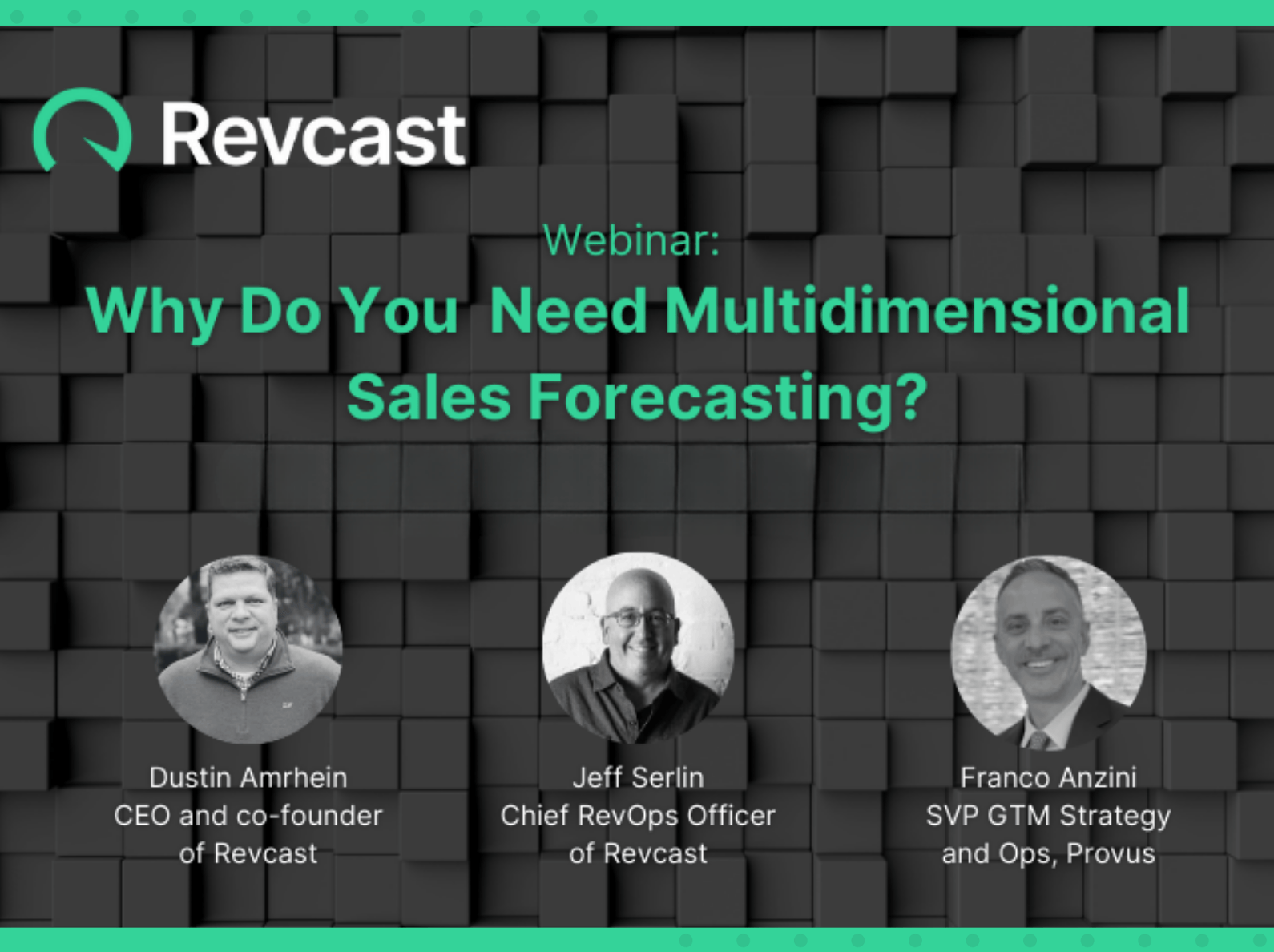Your Sales Forecast Needs More Than Deals
In a recent panel discussion held by Revcast (view full video playback here), revenue leaders Franco Anzini - SVP of GTM Strategy and Ops at Provus, Jeff Serlin - Chief RevOps Officer at Revcast, and host Dustin Amrhein - CEO and co-founder of Revcast explored why sales forecasting can’t just be about deal inspection. The conversation covered the limitations of traditional approaches, how to build a broader forecasting “lens,” and the operational impact of thinking beyond the current quarter.
Let's dive into some of the highlights of the session and some video clips!
Moving Beyond Deal-Only Forecasting
Forecast calls often get stuck in short-term thinking. “We still always bring ourselves back to, how are we going to make this quarter’s number?” said Jeff Serlin. “And when you start doing that, you start looking at pipeline… which are deals. And then we start talking about deals. And I think that’s a mistake, because deals are only one part of it.”
Franco Anzini agreed, noting that at larger companies with set cadences, “If something changes in the business, you’re just continuing to do the same thing, look at the same things… the aperture is not very wide, or maybe not as wide as it should be.”
Dustin Amrhein emphasized that the goal should be connecting forecast data to real business decisions: “How should we evolve go-to-market strategy based on what’s actually happening versus what we thought might happen or what we plan to happen?”
Widening the Lens with Multiple Dimensions
The panelists pointed to four key forecasting dimensions beyond deals: capacity, pipeline, performance, and cost. “You have to look across all of these things to build that confidence,” Jeff said. “If you don’t, you’re going to have major blind spots… Pumping more pipeline with a low-converting source isn’t going to get you there. Maybe hiring on time and retaining your best reps is going to actually get you there.”
Franco highlighted the danger of reviewing these metrics only quarterly: “If you’re only looking at these every quarter, it really minimizes that reaction time… You can act on it, and it can still have impact in the period that you’re in.”
Dustin added that Revcast’s focus is on making these multidimensional insights accessible without overburdening revenue operations: “Before you had systems and reliable data… it was just like roomfuls of people” pulling the data together.
Each of the panelists recounted examples of hard-knocks experiences when forecasting left out any or all of those critical inputs.
Thinking in Ranges, Not Single Numbers
All three panelists agreed that forecasting should produce a range informed by multiple factors—not just a single “commit” number. “By providing a range, you’re showing a deeper understanding of your business,” Franco explained. “Here’s the range, and then here’s what affects the range. It really shows an understanding of the levers that move the variables in your equation.”
Jeff likened it to hurricane tracking: “Where you see the overlap [between forecast factors] it gives you that kind of high probability range of where you’re probably going to end up if you do nothing or just follow the baseline… As you get closer to the end of the quarter, it starts to get smaller, and you get more precision.”
For Dustin, this approach helps leaders manage both current and future quarters: “There are certain things that are true about your business now that will probably be true in the future… You can start to get better at projecting that range for the future, and importantly, get better at seeing the risk and the opportunities that will influence it.”
Final Advice for Evolving Forecast Calls
When asked for one piece of advice to start evolving weekly forecast meetings, Jeff said: “I would start with asking the whys and challenging what you hear, whether it’s great news or whether the news isn’t that good, and try to end up with action.”
Franco echoed the sentiment: “Don’t be afraid to dig and poke around… As you’re asking and inspecting, bring other areas into the conversation—capacity, pipeline quality, performance metrics—that can really surface insightful questions.”
Dustin also acknowledged that moving to multidimensional forecasting puts more requirement for data, analytics, and scenario modeling, but this is an opportunity to use AI solutions, such as Revcast, to assist with not just the "rote" data work but also the co-piloting to assist with the strategic planning side.
If you’d like to explore how to apply multidimensional forecasting in your own organization, you can see more from Revcast’s approach here.





